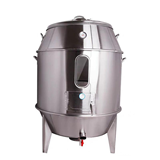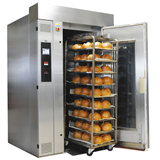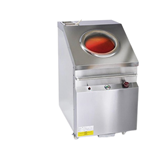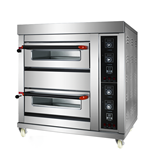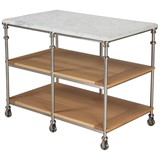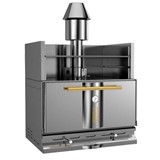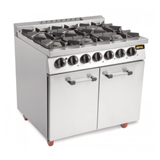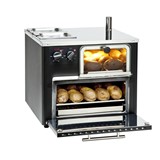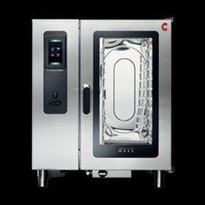Everyone knows the best kind of advertising is word of mouth. One of the easiest ways to ensure this is to make sure return customers have the same fantastic experience, every time.
We receive a lot of questions asking what a combi oven is and the difference between a combi oven and a convection oven. Sometimes it's hard to which is one is best for a particular menu style or kitchen.
In our view, both commercial combi and convection ovens are built for the job, but they both cook up delicious dishes in different ways.
In this article we will give you the run down on the difference between the two and, as an added bonus, which brand we suggest might work best for you in your commercial kitchen. Among other things, we want to ensure you are economising on the space you have and effort it takes to achieve your menu goals your kitchen.
What is a Convection Oven?
A commercial convection oven uses a fan and exhaust system to blow and spread hot air across the cooking cavity and around the food, then vent it back out. This ensures even cooking, removing both hot and cold spots from food and creating the ideal ‘browning’ effect. As a result, this hot air surrounds the food so that it cooks evenly and more quickly. Convection technology also decreases cook times so more food can be made in a shorter amount of time. Butler Equipment offer some of the most sought-after brands of convection ovens on the market.
By far one of our most popular Convection Ovens and frequently requested from us is the Moffats Turbofan Oven. These ovens are very well priced, great quality and a very well recognised piece of kitchen equipment suitable for Cafes, through to restaurants and institutional kitchens.
What is a Combi Oven?
A combi oven uses three methods of cooking in one appliance: convection, steam, and a combination of steam and convection. Convection, or the circulation of dry heat, can be used for baking, roasting and grilling tasks. The steam function delicately poaches fish, steams rice, or cooks vegetables to the perfect texture. When using the combination function, both steam and convection work together to produce results that are moist, flavourful and have minimal shrinkage. Thus, you get more out of your ingredients, adding to the food margin for each dish.
There are many popular brands of combi ovens and, being #KitchenSmart, we understand they are a core part of the efficient commercial kitchen these days. Brands such as Olis, Convotherm and Rational are the most commonly sought-after brands with our Butler Equipment customer base.
All of the above offer state of the art technology and are packed full of time and labour-saving features that turn out quality food time and time again. All with great warranties and after sale service.
One of our favourite Combi Ovens lines is the Olis Electric Touch Combi Oven range. “One Touch” Technology makes Olis Combi Ovens one of the easiest to operate on the market. You are able to set it up and operate it via a Smart Phone or iPad connected to the oven - you can even control it remotely this way!
SO, back to which do you need in your kitchen? Let's compare the common uses in food preparation and cooking and compare oven functions:
What is a Convection Oven Used for?
- Baking
- Broiling
- Grilling
- Roasting
What is a Combi Oven Used for?
- Baking
- Broiling
- Poaching
- Roasting
- Steaming
- Regenerating
- Slow cooking
- Overnight cooking
What are the Benefits of a Convection Oven?
Convection ovens are great to have if you already have a fully functioning kitchen and need to bake, broil or roast in large batches - and they are comparatively economical to purchase.
- Fast cooking – Whether you’re baking large batches of cookies or roasting meat, a commercial convection oven can produce high volumes of food quickly.
- Even cooking – No hot or cold spots because the hot air is evenly circulated throughout the oven producing an evenly cooked meal.
- ‘Browning’ effect – The even circulation of air in the convection oven helps brown your foods, including breads and pastries, perfectly.
- Roasts to perfection – If you like to roast vegetables and meats, the convection oven can create a crispy texture or caramelise better than some of its counterparts.
- Bakes like magic – The heat formed from convection cooking can melt fat and create natural steam. This helps lift dough in pie and air in pastries. It also can bake multiple trays of goodies, such as cookies and biscuits without needing to rotate them.
What are the Benefits of Combi Ovens?
Combi ovens are a big investment - but when compared to the cost of your overall equipment package, the purchase is worth the initial price. These versatile units make smart investments for the following reasons:
- Condense Your Cook Line with Versatility – With a combi oven, you can cook meat, poach fish, steam rice and vegetables and bake breads and pastries. You even can lower the temperatures to hold or slow cook certain items. While the upfront investment is more than any single piece of equipment, it is usually still more cost-efficient than buying multiple pieces of equipment. This is largely due to the reduction in cooking errors, minimising meat shrinkage and sheer output in volumes of dishes.
- Cook More with One Oven – Combi ovens can roast, steam, sous vide, smoke, braise, bake, re-therm, grill and oven fry foods. This makes them a great way to boost capacity or save on space by replacing multiple units on your cook line entirely.
- Precise Temperature and Moisture Control – Accurate controls cook at precise temperature and steam settings, for maximum customisation. Sometimes, steam and convection cooking on their own can dry out and shrink the product. When combined, foods retain the right moisture and this minimises shrinkage.
- Programmable Menus – Programmable menus let you hard load or manually input recipes and cooking modes. This turns even complex recipes with intricate steam and convection settings into the press of a few buttons. “Set and forget” is now a reality!
- Increased Food Yields and keeps the flavour – By using both steam and convection in your recipes you can preserve flavours and nutrients, which results in a higher-quality finished product. This is perfect for meats since the moisture from steam helps to prevent meats from drying out and shrinking, keeping cuts tender and juicy.
- Space saving – By having several cooking modes rolled into one oven, it reduces the need for multiple machines and thus reduces the footprint in a commercial kitchen.
- Automatic Cleaning – Most combi ovens have the added advantage of a built-in automated cleaning system. Whether it use a tablet base or liquid chemical feed, the option of automatic cleaning and descale facilities, this is a true game changer saving time and money and keeping your equipment in pristine condition.
Why Choose a Convection Oven?
No matter the size of your restaurant or commercial kitchen, a convection oven ensures your food maintains the highest quality. From large casual-dining restaurants to small bakeries, this type of oven can cook large amounts of food without wasting time or sacrificing flavour, heat or texture. Also, many convection oven manufacturers offer a wide variety of dimensions to suit your establishment’s needs. Some can be double stacked to save valuable space.
Why Choose a Combi Oven?
If you make a high volume of various foods, or frequently cater for large groups or continuous lines of customers, this is the right option for you. You’ll be able to steam, poach, bake, roast, grill and cook different products without having to purchase multiple pieces of equipment. That’s why they’re perfect for fast food chains, restaurants, taverns and even small commercial kitchens, right through to your largest commercial kitchens. These can also be double stacked to minimise space required in your kitchen.
Things to consider prior to installing a Combi Oven
- Water Quality – Specialised filters are often required in hard water areas and are recommended and often required to comply with warranty conditions on most brands of combi ovens.
- Water Pressure – Combi Ovens require a constant strong water pressure; exact requirements are outlined in each brands installation manual.
- Power Supply – Most Combi Ovens will require adequate 3 Phase Power available.
- Drainage – Most Councils will have a specific requirement regarding drainage, usual a tun dish drain is required - check with your Local Council requirements.
- Exhaust – Your Combi Oven will almost certainly be required to have an adequate exhaust system above it. Please check with your Local Council for their specific Building Code requirements.
For further “Kitchen Smart” Advice on the best Convection Oven or Combi Oven for your kitchen, contact the Butler Equipment Team.







